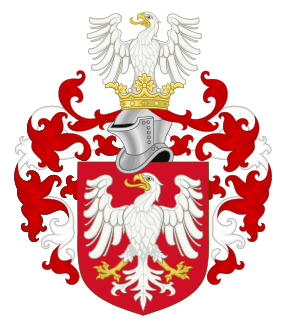
The Piast dynasty was the first historical ruling dynasty of Poland. The first documented Polish monarch was Duke Mieszko I. The Piasts' royal rule in Poland ended in 1370 with the death of king Casimir III the Great.
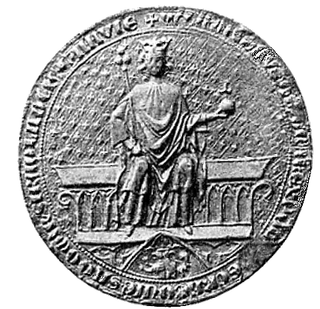
Władysław I Łokietek, in English known as the "Elbow-high" or Ladislaus the Short was King of Poland from 1320 to 1333, and duke of several of the provinces and principalities in the preceding years. He was a member of the royal Piast dynasty, the son of Duke Casimir I of Kuyavia, and great-grandson of High-Duke Casimir II the Just.
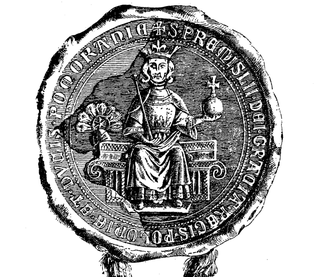
Przemysł II was the Duke of Poznań from 1257–1279, of Greater Poland from 1279–1296, of Kraków from 1290–1291, and Gdańsk Pomerania (Pomerelia) from 1294–1296, and then King of Poland from 1295 until his death. After a long period of Polish high dukes and two nominal kings, he was the first to obtain the hereditary title of king, and thus to return Poland to the rank of kingdom. A member of the Greater Poland branch of the House of Piast as the only son of Duke Przemysł I and the Silesian princess Elisabeth, he was born posthumously; for this reason he was brought up at the court of his uncle Bolesław the Pious and received his own district to rule, the Duchy of Poznań in 1273. Six years later, after the death of his uncle, he also obtained the Duchy of Kalisz.

The Duchy of Greater Poland was a district principality in Greater Poland that was a fiefdom of the Kingdom of Poland. It was formed in 1138 from the territories of the Kingdom of Poland, following its fragmentation started by the testament of Bolesław III Wrymouth. In 1177, the state broke had separated into the duchies of Poznań, Gniezno and Kalisz, and united again in 1279, lasting in that form until 1320, when it was incorporated back into the Kingdom of Poland. Its capital was Poznań.

Przemysł I, a member of the Piast dynasty, was Duke of Greater Poland from 1239 until his death, from 1241 with his brother Bolesław the Pious as co-ruler. He was able to re-acquire large parts of Greater Poland, ruling as Duke of Poznań and Gniezno from 1247 and, upon several inheritance conflicts with his brother, as Duke of Poznań and Kalisz from 1249, sole Duke of Greater Poland from 1250, and Duke of Poznań from 1253 until his death.

Jakub Świnka was a Polish Catholic priest, the Archbishop of Gniezno and a notable politician, supporter of the idea of unification of all Polish lands under the rule of Władysław I the Elbow-high. His coat of arms was Świnka.

This article covers the history of Poland in the Middle Ages. This time covers roughly a millennium, from the 5th century to the 16th century. It is commonly dated from the Fall of the Western Roman Empire, and contrasted with a later Early Modern Period. The time during which the rise of humanism in the Italian Renaissance and the Reformation unfolded, are generally associated with the transition out of the Middle Ages, with European overseas expansion as a succeeding process, but such dates are approximate and based upon nuanced arguments.

Leszek of Masovia was a Polish prince from the Piast dynasty, the Duke of Masovia from 1173 until his death. He was the only son of Bolesław IV the Curly, Duke of Masovia and High Prince of Poland, to survive his father. After his father's death he inherited Masovia. At the beginning, Leszek ruled under the guardianship of his uncle Casimir II the Just. He was a man of poor health. For a short time he supported his other uncle, Mieszko III the Old, but later decided to reconcile with Casimir II, who after Leszek's death inherited his duchy.

Odon of Poznań, also known as Odon of Greater Poland and Mieszkowic, was Duke of Greater Poland in 1179–1181, and Duke of Kalisz from 1193 to 1194.

The United Kingdom of Poland, at the time known as the Kingdom of Poland, was a kingdom in Central Europe. Its capital was Kraków. The state was formed on 20 January 1320, with the coronation of Władysław I Łokietek, from the confederal Kingdom of Poland, that consisted of various duchies. It existed until 1386, when, following the Union of Krewo of 1385 and the subsequent coronation of Władysław II Jagiełło on 4 March, it entered into a personal union with the Grand Duchy of Lithuania, and was reformed as the Crown of the Kingdom of Poland. In 1370, it had an area of 270 000 km² and a population of around 2.5 million people.

The period of rule by the Piast dynasty between the 10th and 14th centuries is the first major stage of the history of the Polish state. The dynasty was founded by a series of dukes listed by the chronicler Gallus Anonymous in the early 12th century: Siemowit, Lestek and Siemomysł. It was Mieszko I, the son of Siemomysł, who is now considered the proper founder of the Polish state at about 960 AD. The ruling house then remained in power in the Polish lands until 1370. Mieszko converted to Christianity of the Western Latin Rite in an event known as the Baptism of Poland in 966, which established a major cultural boundary in Europe based on religion. He also completed a unification of the Lechitic tribal lands that was fundamental to the existence of the new country of Poland.
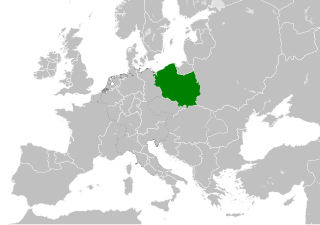
The Duchy of Poland was a duchy in Central Europe with its capital being Gniezno. Its government system was patrimonial monarchy. The state was formed around 960. Mieszko I was crowned as the ruler of Polans between 950 and 960. The state took Christianity as its state religion in 966 durimng Christianization of Poland. The state existed until the coronation of Bolesław I the Brave for the king in 1025, who turned the duchy into the Kingdom of Poland.

The Kingdom of Poland was a kingdom in Central Europe with the capital in Gniezno. Its government system was patrimonial monarchy. The state was reformed in 1025 from the Duchy of Poland, following the coronation of Bolesław I the Brave for the king. Shortly after that, he died being succeeded by his son, Mieszko II Lambert, who became the last ruler of the country. The state existed until 1031, when, after losing the German–Polish War, Mieszko was dethronized and replaced with duke Bezprym, who formed the Duchy of Poland.
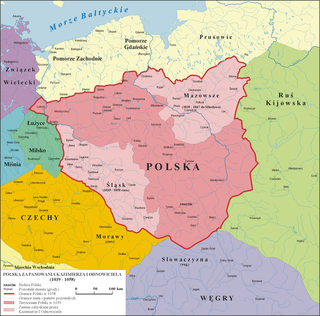
The Duchy of Poland was a duchy in Central Europe with patrimonial monarchy. Until 1038, its capital was Gniezno, and since then, it was Kraków. The state was reformed from the Kingdom of Poland in 1031, following the defeat in the German–Polish War, and dethronization of its ruler, king Mieszko II Lambert. Following that, he got replaced with his brother, Bezprym, who ruled as a duke. The state existed until 1076, when its ruler, Duke Bolesław II the Generous, was crowned King, forming the Kingdom of Poland.

The Duchy of Poland was a duchy in Central Europe with patrimonial monarchy. Its capital was Kraków. The state was reformed from the Kingdom of Poland in 1079, following the dethronization of Bolesław II the Generous, and his replacement on the throne with Władysław I Herman. It existed until 1138, when, following the death of duke Bolesław III Wrymouth, the country was divided between his sons, into duchies of Seniorate Province, Greater Poland, Sandomierz, Masovia and Silesia, with all dukes being under the rule of High Duke of Duchy of Poland residing in the Seniorate Province.

The Duchy of Poland was a confederal duchy in Central Europe consisted of various states under the rule of the High Duke, an office bared by the ruler of the Seniorate Province until 1227. The state was reformed from the Duchy of Poland in 1138 following the fragmentation of the country into the confederation, after the death of Bolesław III Wrymouth. In 1227, the title of High Duke, and the confederal state, got abolished, with the following duchies gaining independence: Kraków, Masovia, Kuyavia, Łęczyca, Sieradz, Dobrzyń, Gdańsk and Świecie and Lubiszewo, Sandomierz, Poznań, Gniezno and Kalisz.
The Kingdom of Poland was a confederal kingdom in Central Europe, that consisted of various states under the rule of the king. Its capital was Kraków. It was formed on 25 July 1300, following the coronation of king Wenceslaus II of Bohemia. After the death of king Wenceslaus III in 1306, the state remained in the period of interregnum, until 20 January 1320, when Władysław I Łokietek was crowned, uniting the confederated duchies into the United Kingdom of Poland.
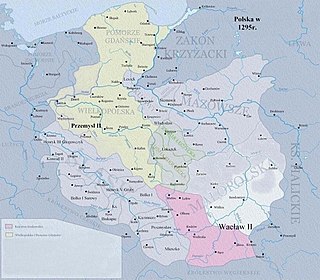
The Kingdom of Poland was a kingdom in Central Europe located in the Greater Poland, existing between 1295 and 1296. It was formed from the Duchy of Greater Poland on 26 June 1295, with the coronation of Przemysł II. Despite the title of the King of Poland used by the ruler, he controlled only the area of Greater Poland and Duchy of Pomerelia, with which the state was in the personal union. Its capital was Poznań. The country existed until 10 March 1296, when after the death of the king Przemysł II on 8 February 1296, the state was partitioned into the Duchy of Greater Poland, with some lands additionally being given to the Margraviate of Brandenburg, and the Duchy of Głogów.
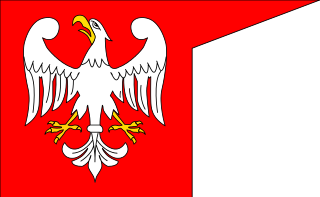
The Duchy of Poznań was a feudal district duchy in the Greater Poland, centered on the Poznań Land. Its capital was Poznań. The state was established in 1177, in the partition of the Duchy of Greater Poland, after the rebellion against Mieszko III. Duke Odon of the Piast dynasty become its first ruler. It existed until 1279, when, it got united with duchies of Gniezno and Kalisz, under the rule of Przemysł II, forming the Duchy of Greater Poland. It remained a fiefdom within the Duchy of Poland, until 1227, and after that, it become an independent state.
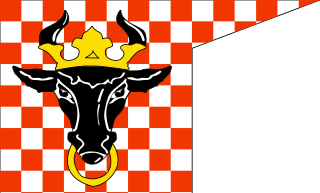
The Duchy of Kalisz was a feudal district duchy in the Greater Poland, centered on the Kalisz Region. Its capital was Kalisz. The state was established in 1177, in the partition of the Duchy of Greater Poland, after the rebellion against Mieszko III. Duke Casimir II the Just of the Piast dynasty become its first ruler. It existed until 1279, when, it got united with duchies of Gniezno and Poznań, under the rule of Przemysł II, forming the Duchy of Greater Poland. It remained a fiefdom within the Duchy of Poland, until 1227, and after that, it become an independent state.



















